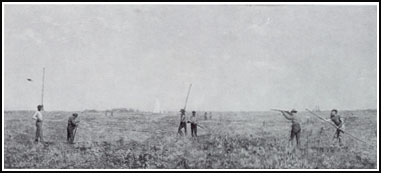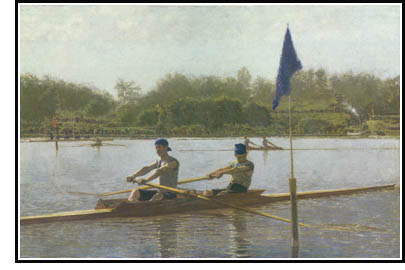 Pushing
for Rail and Will
Schuster and Blackman Going Shooting feature complex acts of coordination
and balance in which one or more boats is held in place and steadied by
one man while another loads his rifle, aims, or fires at a moving target.
Given the incredible instability of a flat-bottomed boat with two men
standing upright in it, the stern man up on the gunwale a foot or more
above the water line (not to mention the destabilizing kick of the gun
being fired), either work is the visual equivalent of painting the Flying
Wallendas executing a pyramid on the high wire. The challenging relation
of intention to execution in these situations is precisely what attracted
Eakins to them.
Pushing
for Rail and Will
Schuster and Blackman Going Shooting feature complex acts of coordination
and balance in which one or more boats is held in place and steadied by
one man while another loads his rifle, aims, or fires at a moving target.
Given the incredible instability of a flat-bottomed boat with two men
standing upright in it, the stern man up on the gunwale a foot or more
above the water line (not to mention the destabilizing kick of the gun
being fired), either work is the visual equivalent of painting the Flying
Wallendas executing a pyramid on the high wire. The challenging relation
of intention to execution in these situations is precisely what attracted
Eakins to them.
Just as he did in the Gross and Agnew works, Eakins presents a double text that emphasizes both the figures' mental focus and their manual mastery–and in fact suggests the inseparability of the two realms. The figures' faces and eyes register intense states of concentration as they aim, fire, and hold the boats steady; at the same time, the care Eakins lavishes on detailing the placement of the pole-pushers' feet, bodies, arms, and hands emphasizes the physical prowess of their performances. (The flickering of the reflected light from the water onto the hull of the boat in the Will Schuster painting in particular reminds us of the precariousness of the men's act of balance. They are not only walking on water, but the water is clearly in motion.)
The paintings imagine performances of balletic balance and agility. Eakins' decision in both paintings to contrast stolid, short, firmly planted, red-shirted hunters with one or more taller, thinner, lighter-shirted, and more delicate looking pole-bearers visually suggests both the strength and the grace necessary in the performances. As the viewer's eye skims across the crystalline surface of Pushing for Rail in particular, the visual play of contrasted body positions and pole placements sets up eddies of suspended motion that capture the dynamic poise of these acts of mutually interdependent balance and timing. The figures are abstracted into a delicate visual interplay of half-rhyming positions. The impression is further heightened by the Dutch-like-sheen and attention to detail of Eakins' diminutive treatment of the subject. The tininess of the figures makes them seem almost weightless; the unnaturally sharp focus of the details makes the acts of balance seem slightly uncanny.
 The
rowing paintings depict similar manual and mental transactions, communicating
the degree to which rowing depends on an intricate interaction of body
and spirit. It is not to much to argue that in these works the mind acts
and the hand thinks to the point that thought becomes indistinguishable
from action. To focus only on The Biglin Brothers Turning the Stake,
the mindfulness of the two rowers in the foreground is communicated not
only by the concentration of their facial expressions, but, as in the
clinic paintings, by the slight inclination of their heads, their positioning
against a neutral background, and the use of a single source of light
(in this case, the sun) to heighten their three-dimensionality (which
contrasts with the flatness of the water's surface behind them). Eakins
employs cool blues (in the kerchiefs, the trim on the brothers' shirts,
the stake flag, and the water around the Biglins' boat) that contrast
with the hotter colors and visual agitation in the painting's background
(the red flag and kerchiefs of the opposing team, the whiter water, and
the visual busyness of the shoreline) to emphasize their meditativeness.
The Biglins may be in the heat of action, but the tones emphasize their
intellectual and emotional coolness. They are in the middle of a race,
at one of its most crucial junctures, but their minds are as calmly composed
as those of doctors Gross and Agnew in the middle of their comparably
demanding manual performances. The deliberate placidity of Eakins' composition
is such that the rowers look as if they were standing still in the water
(the mistaken conclusion many a casual viewer has drawn from the compositional
stillness of the work).
The
rowing paintings depict similar manual and mental transactions, communicating
the degree to which rowing depends on an intricate interaction of body
and spirit. It is not to much to argue that in these works the mind acts
and the hand thinks to the point that thought becomes indistinguishable
from action. To focus only on The Biglin Brothers Turning the Stake,
the mindfulness of the two rowers in the foreground is communicated not
only by the concentration of their facial expressions, but, as in the
clinic paintings, by the slight inclination of their heads, their positioning
against a neutral background, and the use of a single source of light
(in this case, the sun) to heighten their three-dimensionality (which
contrasts with the flatness of the water's surface behind them). Eakins
employs cool blues (in the kerchiefs, the trim on the brothers' shirts,
the stake flag, and the water around the Biglins' boat) that contrast
with the hotter colors and visual agitation in the painting's background
(the red flag and kerchiefs of the opposing team, the whiter water, and
the visual busyness of the shoreline) to emphasize their meditativeness.
The Biglins may be in the heat of action, but the tones emphasize their
intellectual and emotional coolness. They are in the middle of a race,
at one of its most crucial junctures, but their minds are as calmly composed
as those of doctors Gross and Agnew in the middle of their comparably
demanding manual performances. The deliberate placidity of Eakins' composition
is such that the rowers look as if they were standing still in the water
(the mistaken conclusion many a casual viewer has drawn from the compositional
stillness of the work).
The water in front of the Biglins is as calmly reflective as their minds, yet as I have suggested, brain and brawn are always interrelated in Eakins' work. Two small dimples in the river, the contrasted positions of the Biglins' bodies, the flex of the muscles in their arms, and the angles of their oar blades (their degree of "feather" and "catch") all tell us that this moment of mental poise is simultaneously one of tremendous physical exertion. The bow rower (on the right) is pulling backward on his oar with full force while the stern or "stroke" rower is counterpoising his oar with equal force against the movement, employing the resistance of the water to pivot the boat clockwise. (At the moment Eakins has imagined, the boat has all but completed its pivot around the stake and is just about to begin another lap.)
Yet, as I have already suggested, the work being done by the Biglins is mental as much as physical. Even as they are exerting themselves physically, both rowers are making a series of calculations: the bow rower calculating the distance of the stern rower's oar from the stake, making sure it clears it and will continue to clear it on the stroke that is about to begin; the stern rower meanwhile monitoring the boat's alignment with respect to the shore (using a preselected object on the shore to line up the boat), preparing to call out and initiate the regular stroke in unison with the bow rower once the boat is lined up properly to begin the next leg of the course. Eakins imagines a moment of contemplative calm, just prior to a furious unleashing of brute force.
The point of going into what may seem to be unnecessary detail is to suggest not only how much interrelated thinking and doing Eakins has depicted, but how much interrelated thinking and doing the depiction itself involved. Thinking and doing are inseparable for both the rowers and the artist. Just as is impossible to say where the Biglins' mental prowess (their calculations of distances, timing of the pivot, and pacing of the strokes) ends and their physical prowess begins, it is impossible to say where Eakins draftsmanship (his study of perspective, his calculations of angles, sizes, distances, and reflections, and his knowledge of details of rowing) ends and his artistry begins. That is precisely what interested Eakins about this moment–for both the Biglins and himself. As in the clinic and hunting paintings, at a time like this, hand and mind, art and science merge.
That is what it means to say that the events and figures in Eakins' work are surrogates for the representational achievement of the painter himself, who is not merely depicting Agnew's, Gross's, rail hunters', or the Biglins' challengingly coordinated acts of thinking and doing, but is enacting his own course of challengingly coordinated thinking and doing in creating such spatially and temporally detailed works....
–Excerpted from Ray Carney, "When Mind is a Verb: Thomas Eakins and the Doing of Thinking," in Morris Dickstein (ed.) The Revival of Pragmatism: New Essays in Social Thought, Law, and Culture (Durham, NC: Duke University Press, 1998), pp. 377–403.
The preceding material is a brief excerpt from Ray Carney's writing about American painting. To obtain the complete text of this piece or to read more discussions of American art, thought, and culture by Prof. Carney, please consult any of the three following books: American Vision (Cambridge University Press); Morris Dickstein, ed. The Revival of Pragmatism: New Essays on Social Thought, Law, and Culture (Duke University Press); and Townsend Ludington, ed. A Modern Mosaic: Art and Modernism in the United States (University of North Carolina Press). Information about how to obtain these books is available by clicking here.